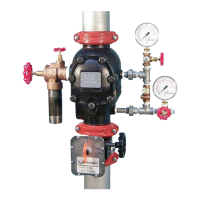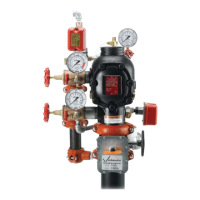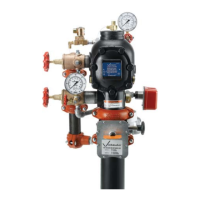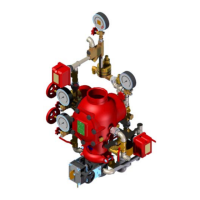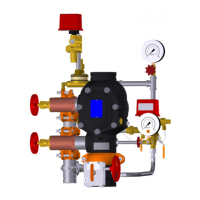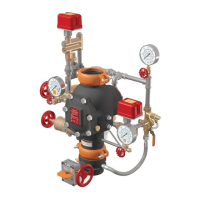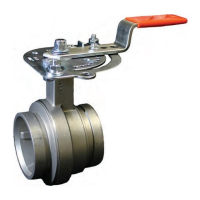11
INSPECTION AND TESTS
WEEKLY INSPECTION
It is recommended that a visual inspection be performed
on the preaction system and trim on a weekly basis. If the
preaction system is equipped with a low pressure alarm,
monthly inspections may be sufficient.
1. Record the system pressures. Confirm that the water
supply pressure is in the range of normal pressures
observed in the area. Significant loss in supply pressure
could indicate an adverse condition in the water supply.
Confirm that the proper air-to-water pressure ratio is being
maintained.
2. Confirm that there is no leakage from the intermediate
chamber of the valve. No water should flow from the ball
drip. Refer to the troubleshooting section.
3. Check for mechanical damage or corrosion. If found,
perform maintenance on the affected parts.
4. Confirm that the valve and trim are not subject to freez-
ing conditions.
5. Verify that all system valves are in their normal operat-
ing positions.
6. If the preaction system is equipped with the Series 746
Accelerator, record the pressure in the upper chamber of
the accelerator. This pressure should equal the system air
pressure within the allowable tolerances of the gauges. If
the upper chamber air pressure is below the system air
pressure, follow the troubleshooting procedure for the
accelerator.
REQUIRED TESTS
Main Drain Test
Perform the main drain test on a frequency required by the
current NFPA-25 code. The authority having jurisdiction in
your area may require that you perform these tests on a
more frequent basis. Verify these requirements by contact-
ing the authority having jurisdiction in your affected area.
1. Inform the authority having jurisdiction, remote station
alarm monitors, and anyone in the affected area that the
test will be performed.
2. Perform and record the monthly visual inspection.
3. Confirm that you have sufficient drainage for a full flow
drain test.
4. Record the water supply pressure and the pilot system
air pressure.
5. Verify that the intermediate chamber of the preaction
system is dry. No water should flow from the ball drip.
6. For pneumatic systems: Verify that the preaction
system and pilot line are pressurized at the proper air pres-
sure for the local water supply pressures.
7. Open the water supply main drain valve fully.
8. With the water supply drain valve fully open, record the
water supply pressure. Record this as the residual pres-
sure.
9. Close the water supply main drain valve slowly.
10. Compare the residual pressure reading taken above to
the residual pressure readings taken in previous main
drain tests. If there is a degradation in the residual water
supply readings, take the appropriate measures to restore
proper water supply pressure.
11. Record the water pressures established after closing
the main drain. Confirm that all ball valves are in their
proper positions.
12. Notify the authority having jurisdiction, remote station
alarm monitors, and those in the affected area that the
valve has been placed back in service. Provide test results
to the authority having jurisdiction, if required.
The owner is responsible for maintaining the preaction system in proper operating
condition.
• It is important that you inspect and test this preaction system regularly, according to
proper procedures.
• The Victaulic Series 758 Preaction Valve and trim must not be exposed to foreign
matter, corrosive atmospheres, freezing conditions, contaminated water supplies,
or any other condition that could impair the proper operation of the system.
• You must modify the frequency of inspections in the presence of any environmental
conditions that could degrade the system’s operation.
• The National Fire Protection Association Pamphlet, which describes the care and
maintenance of sprinkler systems, outlines the minimum requirements for tests and
inspections.
• In addition, the authority having jurisdiction may have maintenance, inspection, and
test requirements that must be followed.
Failure to follow these instructions may result in serious personal injury, property
damage, and/or system failure.
• Any service that requires taking the system out of service may elim-
inate the fire protection provided by the system. Prior to servicing or
testing the system, notify the authority having jurisdiction of the op-
eration being performed. Consideration of a fire patrol should be
given in the affected areas.
Failure to do so could result in serious personal injury, and/or property
damage.
• Be careful not to open the system main drain accidentally.
Opening the system main drain will cause the system to operate, which may result in
property damage.
